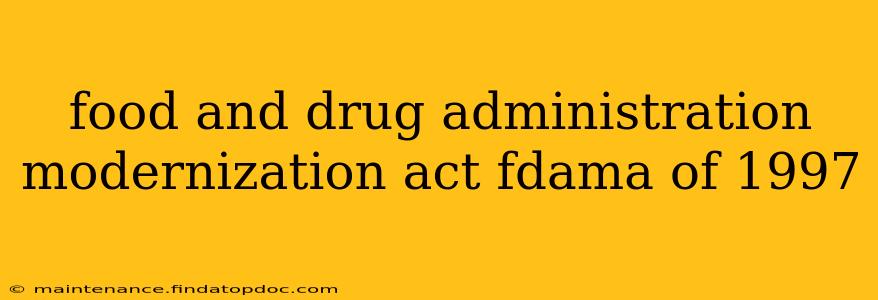The Food and Drug Administration Modernization Act (FDAMA) of 1997 significantly reshaped the landscape of the United States Food and Drug Administration (FDA). This landmark legislation introduced sweeping changes to the agency's structure, processes, and authority, impacting everything from drug development to food safety. Its primary goal was to streamline the FDA's operations, encourage innovation, and ultimately protect public health. This article provides a comprehensive overview of FDAMA, exploring its key provisions and lasting impact.
What are the Main Goals of the Food and Drug Administration Modernization Act of 1997?
FDAMA's central objectives were multifaceted, aimed at modernizing the FDA's approach to regulation and fostering a more efficient and responsive agency. Key goals included:
- Streamlining the drug approval process: Reducing the time it took to bring safe and effective drugs to market.
- Encouraging the development of new drugs and treatments: Particularly for serious and life-threatening conditions.
- Improving the safety and efficacy of medical products: Enhancing the FDA's oversight and regulatory mechanisms.
- Increasing transparency and communication: Fostering better collaboration between the FDA, industry, and the public.
- Updating and strengthening food safety regulations: Addressing emerging concerns and challenges in the food industry.
What are the Key Provisions of FDAMA?
FDAMA's impact spanned numerous areas within the FDA's purview. Some of its most significant provisions include:
- Faster drug approvals: The act introduced provisions to expedite the review and approval of new drugs, including the establishment of fast-track procedures for promising therapies.
- Orphan drug designation: It strengthened incentives for developing drugs to treat rare diseases (orphan drugs) by offering extended market exclusivity.
- Increased user fees: To fund the FDA's operations and reduce review times, the act implemented a system of user fees paid by pharmaceutical companies.
- Dietary supplement regulation: It clarified the regulatory framework for dietary supplements, establishing labeling requirements and setting standards for good manufacturing practices (GMPs).
- Medical device regulation: The act updated regulations for medical devices, focusing on improved safety and efficacy.
- Enhanced communication and transparency: Provisions were included to improve communication between the FDA and the public, fostering greater transparency in the regulatory process.
What Changes Did FDAMA Make to the Process of Approving New Drugs?
FDAMA significantly altered the drug approval process, primarily by introducing mechanisms to accelerate the review of promising new drugs. This included:
- Fast track designation: For drugs intended to treat serious or life-threatening conditions with unmet medical needs.
- Breakthrough therapy designation: For drugs demonstrating substantial improvement over available therapies.
- Priority review: For drugs that offer significant advancements in treating serious conditions.
- Accelerated approval: For drugs that demonstrate a surrogate endpoint that is reasonably likely to predict clinical benefit.
These designations allowed for prioritized review and potentially faster approval timelines, leading to quicker access to innovative therapies for patients.
How Did FDAMA Impact the Regulation of Dietary Supplements?
Before FDAMA, the regulatory landscape for dietary supplements was less defined. The act established a new regulatory framework, clarifying that:
- Dietary supplements are not drugs or food additives. They are regulated differently, under a more flexible framework.
- Manufacturers are responsible for ensuring the safety of their products before they are marketed.
- Labeling requirements are in place, specifying ingredients and providing information about potential health effects.
- Good Manufacturing Practices (GMPs) standards are enforced to ensure quality control in the manufacturing process.
What is the Lasting Impact of the Food and Drug Administration Modernization Act?
FDAMA’s influence continues to be felt today. It significantly modernized the FDA, leading to:
- Faster drug approvals: Patients have quicker access to new therapies.
- Increased innovation in drug development: The incentives created encouraged pharmaceutical companies to invest in research and development.
- Enhanced public health protection: Through improved safety and efficacy standards for drugs, medical devices, and food products.
- Greater transparency and accountability: The improved communication and information sharing fosters public trust.
However, FDAMA is not without its critics. Some argue that it has prioritized speed over thoroughness in drug approval, potentially compromising safety in some instances. The balance between rapid innovation and robust safety regulation remains a key ongoing challenge for the FDA.
This overview provides a comprehensive understanding of the FDAMA of 1997, its key provisions, and its lasting impact on the FDA and the healthcare landscape. Further research into specific areas of interest, such as orphan drug development or dietary supplement regulation, can provide deeper insights into the complexities and nuances of this important legislation.
